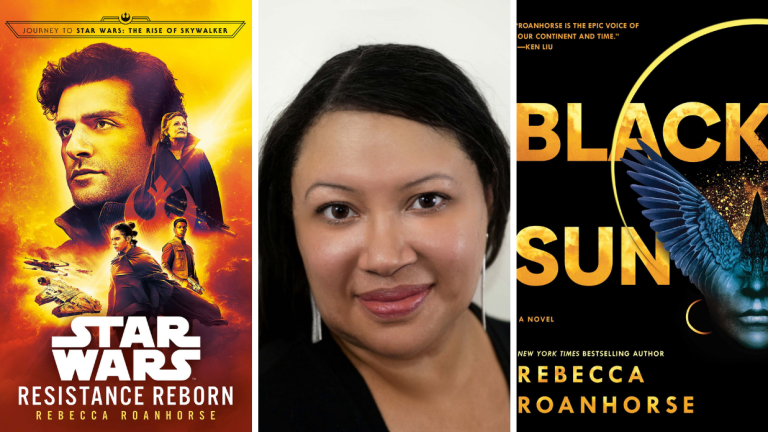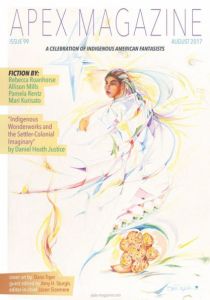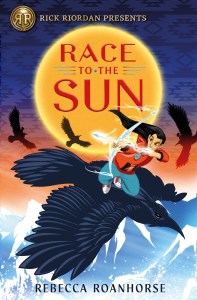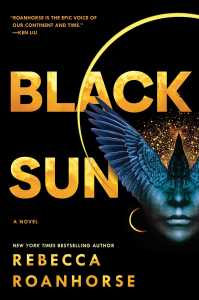An Introduction to the Works of Rebecca Roanhorse
In the past few years, Rebecca Roanhorse has taken the speculative fiction world by storm. Here's what you need to know about her work so far...

Rebecca Roanhorse launched into high visibility in SFF with her short story “Welcome to Your Authentic Indian Experience” in 2017, and her works have continued to wow readers of all ages (she writes fiction for adults, middle grade, and young adults). Her prose is gorgeous, and she takes a hard right turn from more traditional, European-influenced fantasy in her epic new novel, Black Sun. Along with her original works, Roanhorse has also written several Star Wars stories, and is a contributor to Marvel’s new comic anthology Indigenous Voices. If you’re interested in the future of SFF, you can bet your stars that Roanhorse is going to continue to be in the spotlight.

“Welcome to Your Authentic Indian Experience”
Roanhorse’s short story, published in APEX, won both the Hugo and the Nebula. It’s a story about identity, both who you really are and who the world expects you to be. Told in second person, it follows Jesse Turnblatt, who works at a virtual reality Experience, giving Tourists “authentic” Vision Quests that he’s created based on what the typically New Age customers expect from television and movies. When he meets a lonely young man who seems to want something actually real, he realizes that he also needs a friend. But the story takes a Single White Female twist, and leaves Jesse questioning his own reality. It’s a chilling story about erasure and gaslighting that uses SF tropes to maximum effect.

The Sixth World
With Trail of Lightning, Roanhorse’s first published novel, the author entered the urban fantasy genre, telling the story of Maggie Hoskie, a monster hunter, in a post-apocalyptic, flooded world. She’s been trained by a legendary immortal—with whom she also fell in love, but who abandoned her. Now, she’s struggling to decide whether her talent with violence makes her the hero or just another monster. When she becomes involved in solving a string of killings, she accepts help from modern medicine man Kai, who balances her violence with healing. Den of Geek talked to Roanhorse about bringing Native American characters into the urban fantasy genre, and centering Indigenous heroes in the spotlight.
The second novel, Storm of Locusts, follows Maggie out of the Navajo reservation, Dinétah, as she searches for Kai. The medicine man has fallen in with a cult, according to her leads, but Maggie doesn’t think that’s quite right—there’s more going on than meets the eye. Maggie heads out on a post-apocalyptic road trip to track down her friend, and fight whatever monsters she has to take down to save him. Like Trail of Lightning, the book is told from Maggie’s point of view in a clipped, first person present tense voice.
Roanhorse told Den of Geek that four books are planned, and noted that the most difficult part of writing the series was in getting the representation right. Maggie is Diné—Navajo—and Roanhorse is not. “I’ve lived on the Navajo reservation and I’m married to a Navajo man, but it’s not my culture. I wanted to be very careful about the stories I chose to use, the way that I portrayed people and places and everything that went into the world-building I tried to be very conscious that this was going to be a lot of people’s first introduction to Navajo culture, and that I’d have a lot of Navajo readers. I didn’t want to let them down. I didn’t want to get it wrong.”
Critics have praised Roanhorse’s work—Trail of Lightning was a finalist for the Nebula, Hugo, and World Fantasy Award, and it won the Locus First Novel Award—but she has also received criticism from the Navajo Writers’ Association and others for writing Diné characters when she is not Navajo herself. Nick Martin in The New Republic summed up the criticisms, writing an article ultimately supporting Roanhorse and suggesting that, because Roanhorse is also Black, some of the criticism stems from anti-Black prejudice.

Race to the Sun
With Race to the Sun, a middle grade novel for the Rick Riordan Presents imprint, Roanhorse introduces readers to Nizhoni, a Monsterslayer—heir to the Hero Twin of the same name—who has to stop monsters from taking over the world. The mission of the monsters is to destroy the earth (Nizhoni’s first foe, in his human guise, is the CEO of a pipeline fracking on Native Land). Nizhoni has always wanted to be special, but she’s not quite sure she and her younger brother—who takes on the role of Born of Water, the second Hero Twin—are ready for these challenges. Like the Sixth World books, Race to the Sun draws heavily on Navajo tradition and religion and features a fast, first person present-tense voice that makes the action feel immediate. Nizhoni’s personality shines through her narrative, and because she’s a seventh grader, her voice has a lot more levity than Maggie’s. (She also has her horned toad stuffed animal come to life and serve as a guide to her adventure.)
Like several other books in the “Rick Riordan Presents” series, Nizhoni is a chosen hero, given a time limit to fix a grave supernatural problem, who meets up with the supernatural beings of her cultural tradition over the course of her adventures. (The heroes of Riordan’s own “Percy Jackson and the Olympians” books and Roshani Chokshi’s “Aru Shah” books helped establish that pattern.) Nizhoni’s voice also parallels those heroes: she’s got some sass and sarcasm in her narrative that she might not share out loud, but readers are tuned into her inner thoughts, and they hear it all. Race to the Sun includes more of all the things fans love about books from this imprint (which also includes works by Carlos Hernandez and Yoon Ha Lee).

Star Wars: Resistance Reborn
Roanhorse has also contributed fiction to the Star Wars universe, including her Darth Maul vs. Obi-wan Kenobi story in Star Wars: The Clone Wars: Stories of Dark and Light (narrated in audio by Maul’s voice actor, Sam Witwer) and her novel, Resistance Reborn. Set between The Last Jedi and Rise of Skywalker, the novel opens with General Leia still grappling with her near-death—and too-brief reunion with her brother—as she tries to find out why Resistance allies never showed up to help on Crait. Meanwhile, Poe Dameron and his Black Squadron play diplomat while struggling to come to terms with that same question. Is the Resistance really alone in the Galaxy? Unlike Roanhorse’s other novels, Resistance Reborn takes a more classic shared-world style of narration, shifting perspectives among the different characters. Her inner narration of Leia is spot on, depicting both her suffering and her continual ability to move on in spite of it. The tone is reminiscent of the old Star Wars Expanded Universe books, and for readers curious about that same question of why allies didn’t show up until the end of Rise of Skywalker, this is likely to offer a few answers (while giving readers more time to spend with favorite characters).

Black Sun
With Black Sun, Roanhorse moves in an entirely different direction from all her previous work, creating a stunning epic fantasy in a lush secondary world. Like Resistance Reborn, she uses a third-person narration who switches between the characters’ perspectives, but here, she uses beautifully lyrical prose, steeped in the mythology of this new world. Moving in and out of time, Roanhorse weaves together the story of a broken city, once governed by benevolent priests who kept the peace, but now corrupted by political struggles and the interests of foreign nations. The story opens with Serapio, whose mother is engaging in a ritual she’s prepared him for by carving his skin; it culminates in her stitching his eyes shut. As the narrative progresses, readers learn that the ritual allowed Serapio to become an avatar of the Crow god, whose people were brutally murdered a generation earlier by the priests dedicated to the Sun. The point of view characters—Serapio, earnest and justice-driven Sun Priestess Naranpa, and earthy Xiala, a ship captain descended from Mother Ocean herself—are all deeply drawn and sympathetic, even when they are at odds with each other, making it difficult to know who to root for.
In her worldbuilding, Roanhorse leaned on pre-Columbian civilizations, and borrowed a bit from Polynesian navigators, to create a fantasy that feels both familiar and entirely new. “It still seems incredibly rare to find a fantasy inspired by the Americas,” she writes in her acknowledgments. “I think part of the reason is the persistent myth that the indigenous cultures pre-conquest were primitive and had little to offer, when the opposite is true.” Roanhorse’s Meridian is pure fantasy, populated with megafauna such as giant crows that can be ridden, and huge water striders that pull barges, but it shows the richness of being inspired by cultures of North America. The city of Tova borrows designs from the ancient cities of the Anasazi, built into cliff faces, but the divide between the Sky Made who live above and the people of the Maw, who live below in poverty, feels both modern and relevant. Though Black Sun concludes a full story and brings this first volume to a satisfying close, the story is by no means over; Black Sun is clearly the first step in a longer epic narrative, and it’s one readers will be impatiently waiting for until the sequel comes out.
Whether she’s taking on your favorite franchise characters or in her original works, Roanhorse is absolutely an author to watch.
